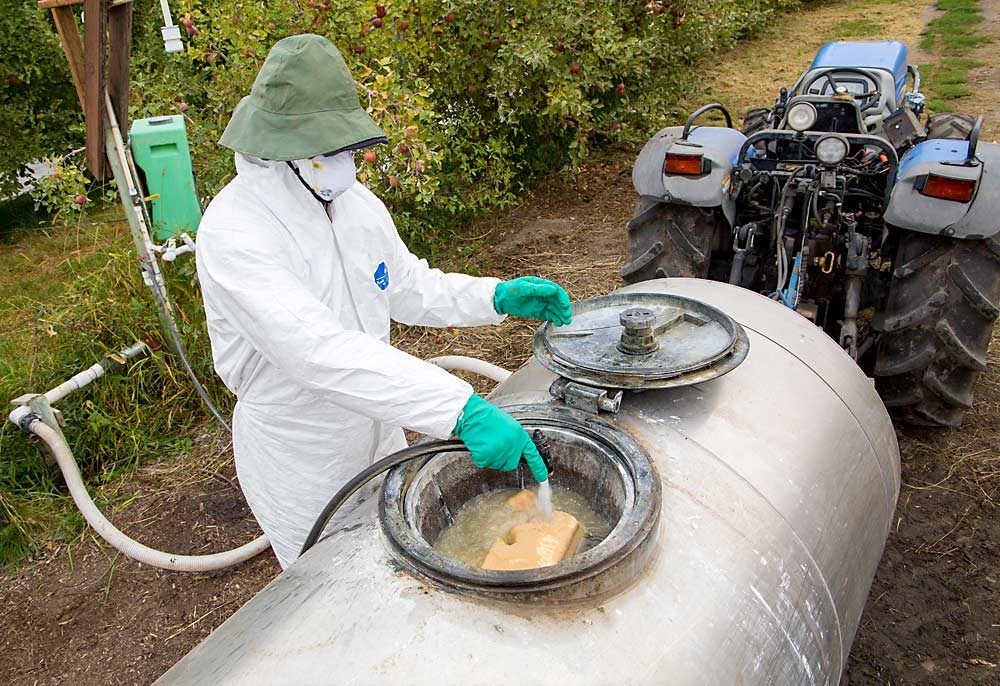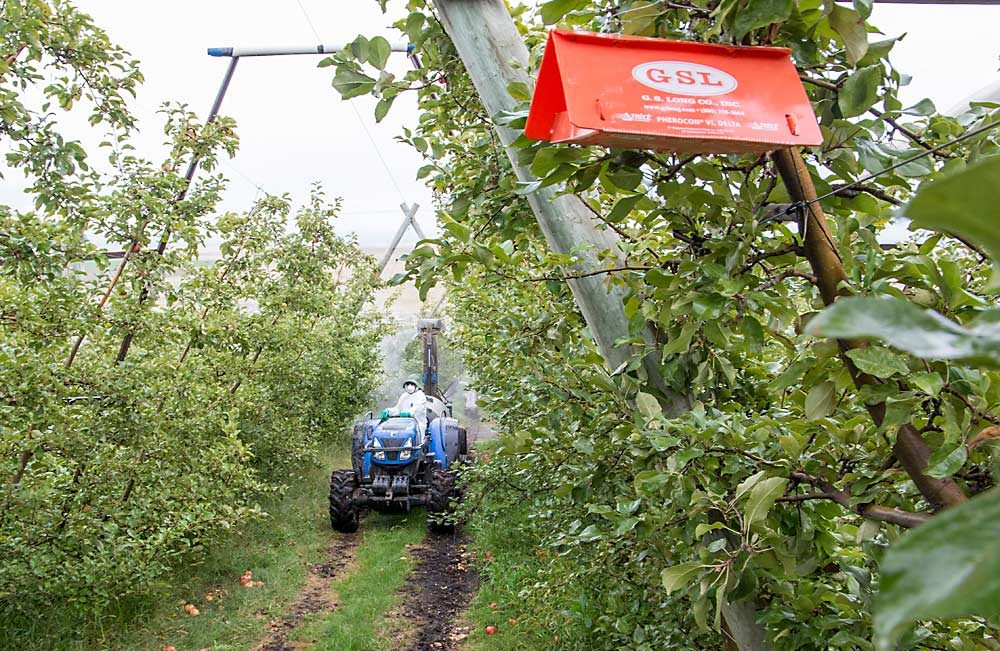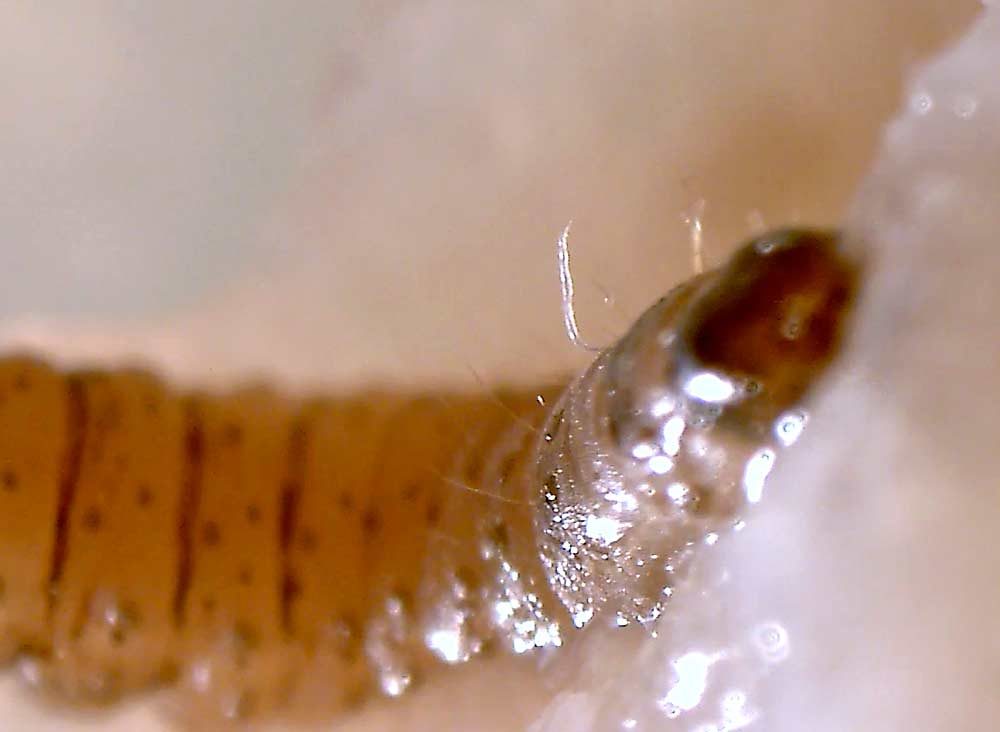Nematodes hardly seem like a biological control for codling moth when they arrive. They resemble a sponge inside a Lunchables packet.
But pull them from the fridge, remove the plastic wrap, mix them with water in a spray tank and apply to trees. That’s when they go to work, wriggling inside codling moth larvae to devour the pests from the inside out.
“You just put them in the sprayer just like you do anything else and go out there,” said Andy Arnold of Wahluke Heights Orchard near Mattawa, Washington.
After high codling moth pressure in 2018 at his family’s organic farm, Arnold turned to nematodes this year as an addition to his biological pest control regimen. He applied a round in the spring, liked what he saw and ran another course in the fall with the hope of knocking down the overwintering population.
Nematodes are tiny nonsegmented worms. Some pose a pest problem while other beneficial species are produced by several companies as a natural control for a wide array of pests. Arbico Organics, Buglogical Control Systems and Beneficial Insectary are among a few producers. Some garden-sized packages are even available on Amazon.
The species Arnold deployed was commercialized by the German chemical company BASF and packaged for use in production agriculture. The juvenile stage is isolated from natural settings and mass-produced through a fermenting process to eat the larvae of about 20 pests, including codling moth, oriental fruit moth and black vine weevil.
And if you believe the video footage, boy are they hungry.

Bred to devour
They attack in a gruesome fashion. The worms enter the codling moths through spiracles, or pores, or any other opening they can find, devour their hosts from the inside, multiply and then eat their way out to search for more victims. A microscope-enhanced video of their destruction was quite the crowd pleaser at the 2018 Washington State Tree Fruit Association Annual Meeting, where the audience reacted with a mixture of groans and laughter.

“You can see, she is not so happy,” BASF’s Diana Londoño told the crowd as she played video of a larvae flinching and squirming to escape attacking nematodes a fraction of her size. Londoño is the global technical manager for bioinsecticides for BASF, based in Research Triangle Park in North Carolina.
So far, BASF commercially sells five nematodes in the United States, including a species that works on thrips and black vine weevil, Londoño said. The company also is developing a species that controls spotted wing drosophila.
Nematodes won’t affect beneficial insects, such as predators and pollinators, Londoño said. They have a 30-year commercial history in Europe as evidence. The juvenile worms can’t travel more than a few inches and only can attack defenseless larvae.
Don’t worry about human exposure either, Londoño said. Instructions still call for personal protective equipment, but stomach acid would kill nematodes instantly.
BASF designed nematodes to work with airblast sprayers running without screens, to avoid clogs. The company recommends fall applications but spring works, too. They get the best results when applied in early morning or late afternoon to dampened soil and tree trunks away from direct sunlight, allowing the worms to seek out larvae in tree bark crevices or the ground.

And the pest must be present; the nematodes will starve to death in a matter of days without food. They ship in refrigerated bread-sized spongy bricks of 3 billion worms that will work on about four acres.
They are compatible with organic certification and conventional orchards and they require no re-entry wait. There is no such thing as resistance to nematodes and therefore no danger of overapplication.
BASF does not pitch the nematodes as a singular solution, Londoño said. Like many biological controls, they are just one tool. “It is not a silver bullet, so you have to apply with other things,” she said.
Worth a try

Arnold, a third-generation farmer in the Columbia Basin, hopes nematodes can help stabilize his IPM program after last year’s codling moth “abomination” prompted him to use Entrust (spinosad), an expensive organic broad-spectrum spray that also kills beneficial insects. It was either that or lose his orchard, he said. In one block of Honeycrisp, he harvested only about half the volume he expected in 2018, due to codling moth damage.
Entomologists agree that codling moth has taken off in recent years. Tried and true mating disruption and other soft techniques work best at lower populations.
Nematodes are cheaper than Entrust, but not by much, Arnold said. He paid roughly $100 per acre through G.S. Long Co. for applying nematodes and $123 per acre for Entrust, not including labor. BASF estimated his fall application should kill about half his overwintering larvae.

Arnold tried an application in the spring to some of his high-pressure areas and, anecdotally, it seemed to help, at least enough for fall application in his Honeycrisp block where he had the codling moth problem. He’s willing to try about anything against the surging populations.
“I’m speculating along with the rest of the industry why this is so, but at the end of the day, I need to react to it,” he said. •
—by Ross Courtney






Leave A Comment